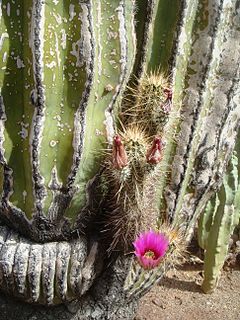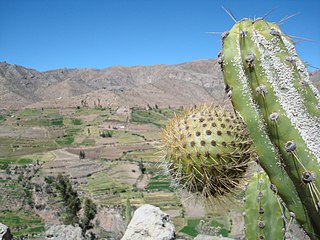
Homo ergaster is an extinct species or subspecies of archaic humans who lived in Africa in the Early Pleistocene. Whether H. ergaster constitutes a species of its own or should be subsumed into H. erectus is an ongoing and unresolved dispute within palaeoanthropology. Proponents of synonymisation typically designate H. ergaster as "African Homo erectus" or "Homo erectus ergaster". The name Homo ergaster roughly translates to "working man", a reference to the more advanced tools used by the species in comparison to those of their ancestors. The fossil range of H. ergaster mainly covers the period of 1.8 to 1.7 million years ago, with a handful of older and younger specimens extending the range to about 2 and 1.5 million years ago respectively. Though fossils are known from across East and Southern Africa, most H. ergaster fossils have been found along the shores of Lake Turkana in Kenya. There are later African fossils, some younger than 1 million years ago, that indicate long-term anatomical continuity, though it is unclear if they can be formally regarded as H. ergaster specimens. As a chronospecies, H. ergaster may have persisted to as late as 600,000 years ago, when new lineages of Homo arose in Africa.

Meganthropus is an extinct genus of non-hominin hominid ape, known from the Pleistocene of Indonesia. It is known from a series of large jaw and skull fragments found at the Sangiran site near Surakarta in Central Java, Indonesia, alongside several isolated teeth. The genus has a long and convoluted taxonomic history. The original fossils were ascribed to a new species, Meganthropus palaeojavanicus, and for a long time was considered invalid, with the genus name being used as an informal name for the fossils.

Homo is the genus that emerged in the genus Australopithecus that encompasses the extant species Homo sapiens, plus several extinct species classified as either ancestral to or closely related to modern humans, most notably Homo erectus and Homo neanderthalensis. The genus emerged with the appearance of Homo habilis just over 2 million years ago. Homo, together with the genus Paranthropus, is probably sister to Australopithecus africanus, which itself had previously split from the lineage of Pan, the chimpanzees.

Java Man is an early human fossil discovered in 1891 and 1892 on the island of Java. Estimated to be between 700,000 and 1,000,000 years old, it was, at the time of its discovery, the oldest hominid fossils ever found, and it remains the type specimen for Homo erectus.

Conocarpus erectus, commonly called buttonwood or button mangrove, is a mangrove shrub in the family Combretaceae. This species grows on shorelines in tropical and subtropical regions around the world.

Homo rhodesiensis is the species name proposed by Arthur Smith Woodward (1921) to classify Kabwe 1, a Middle Stone Age fossil recovered from a cave at Broken Hill, or Kabwe, Northern Rhodesia .. The skull was recently dated to 324,000 to 274,000 years ago. Other similar older specimens also exist.

Corryocactus is a genus of cactus. The genus was formerly placed in the tribe Notocacteae.

Human taxonomy is the classification of the human species within zoological taxonomy. The systematic genus, Homo, is designed to include both anatomically modern humans and extinct varieties of archaic humans. Current humans have been designated as subspecies Homo sapiens, differentiated according to some from the direct ancestor, Homo sapiens idaltu.

Pachycereeae is a tribe of 15 genera of columnar cacti in the subfamily Cactoideae. They are native to Central America, Mexico, and the southwestern United States.

Megalochelys atlas is an extinct species of giant cryptodiran tortoise from the Late Miocene through to the Early Pleistocene periods. During the dry glacial periods it ranged from western India and Pakistan to as far east as Sulawesi and Timor in Indonesia, though the island specimens likely represent distinct species. It has been suggested that Megalochelys sivalensis is the correct name for the taxon, though this is disputed.

Pithecanthropus Erectus is a 1956 album by jazz composer and bassist Charles Mingus. Mingus noted that this was the first album where he taught arrangements to his musicians by ear in lieu of putting the chords and arrangements in writing.

Prehistoric Asia refers to events in Asia during the period of human existence prior to the invention of writing systems or the documentation of recorded history. This includes portions of the Eurasian land mass currently or traditionally considered as the continent of Asia. The continent is commonly described as the region east of the Ural Mountains, the Caucasus Mountains, the Caspian Sea and Black Sea, bounded by the Pacific, Indian, and Arctic Oceans. This article gives an overview of the many regions of Asia during prehistoric times.

Nanjing Man is a subspecies of Homo erectus found in China. Large fragments of one male and one female skull and a molar tooth of H. e. nankinensis were discovered in 1993 in the Hulu cave on the Tangshan hills near Nanjing. The term Nanjing man is used to describe the subspecies of Homo erectus but is also used when referring to the three fossils. The specimens were found in the Hulu limestone cave at a depth of 60–97 cm by Liu Luhong, a local worker. Dating the fossils yielded an estimated age of 580,000 to 620,000 years old.

Homo erectus is an extinct species of archaic human from the Pleistocene, with its earliest occurrence about 2 million years ago, and its specimens are among the first recognisable members of the genus Homo. H. erectus was the first human ancestor to spread throughout the Old World, having a distribution in Eurasia extending from the Iberian Peninsula to Java. African populations of H. erectus are likely to be the ancestors to several human species, such as H. heidelbergensis and H. antecessor, with the former generally considered to have been the ancestor to Neanderthals and Denisovans, and sometimes also modern humans. Asian populations of H. erectus may be ancestral to H. floresiensis and possibly to H. luzonensis. As a chronospecies, the time of the disappearance of H. erectus is a matter of contention. There are also several proposed subspecies with varying levels of recognition. The last known record of morphologically recognisable H. erectus are the Solo Man specimens from Java, around 117–108,000 years ago.

The Drimolen Palaeocave System consists of a series of a terminal Pliocene to early Pleistocene hominin-bearing palaeocave fills located around 40 kilometres (25 mi) north of Johannesburg, South Africa, and about 6 kilometres (3.7 mi) north of Sterkfontein in the UNESCO World Heritage Site Cradle of Humankind.

Homo luzonensis, also locally called ubag after a mythical caveman, is an extinct, possibly pygmy, species of archaic human from the Late Pleistocene of Luzon, the Philippines. Their remains, teeth and phalanges, are only known from Callao Cave in the northern part of the island dating to before 50,000 years ago. They were initially identified as belonging to modern humans in 2010, but in 2019, after the discovery of more specimens, they were placed into a new species based on the presence of a wide range of traits similar to modern humans as well as Australopithecus and early Homo.

Bromus erectus, commonly known as erect brome, upright brome or meadow brome, is a dense, course, tufted perennial grass. It can grow to 120 centimetres (47 in). Like many brome grasses the plant is hairy. The specific epithet erectus is Latin, meaning "erect". The diploid number of the grass is 56.

Megalochelys is an extinct genus of cryptodiran tortoises that lived from the Miocene to Pleistocene, across Asia and possibly Eastern Europe. They are noted for their giant size, which is among the largest of any known testudine, with a maximum carapace length over 2 m in M. atlas.

Corryocactus brevistylus or is a species of columnar cactus found in Peru.


















